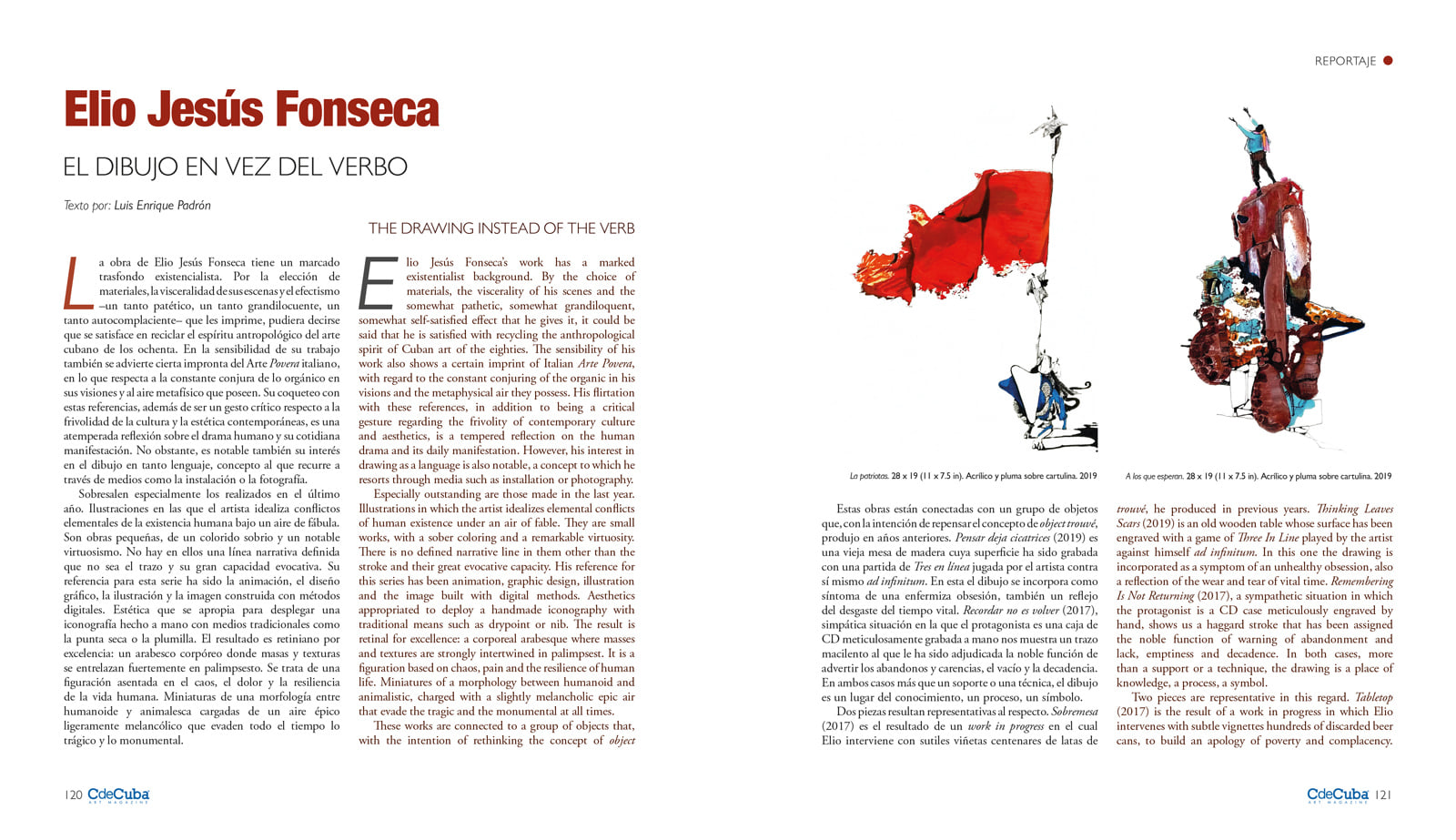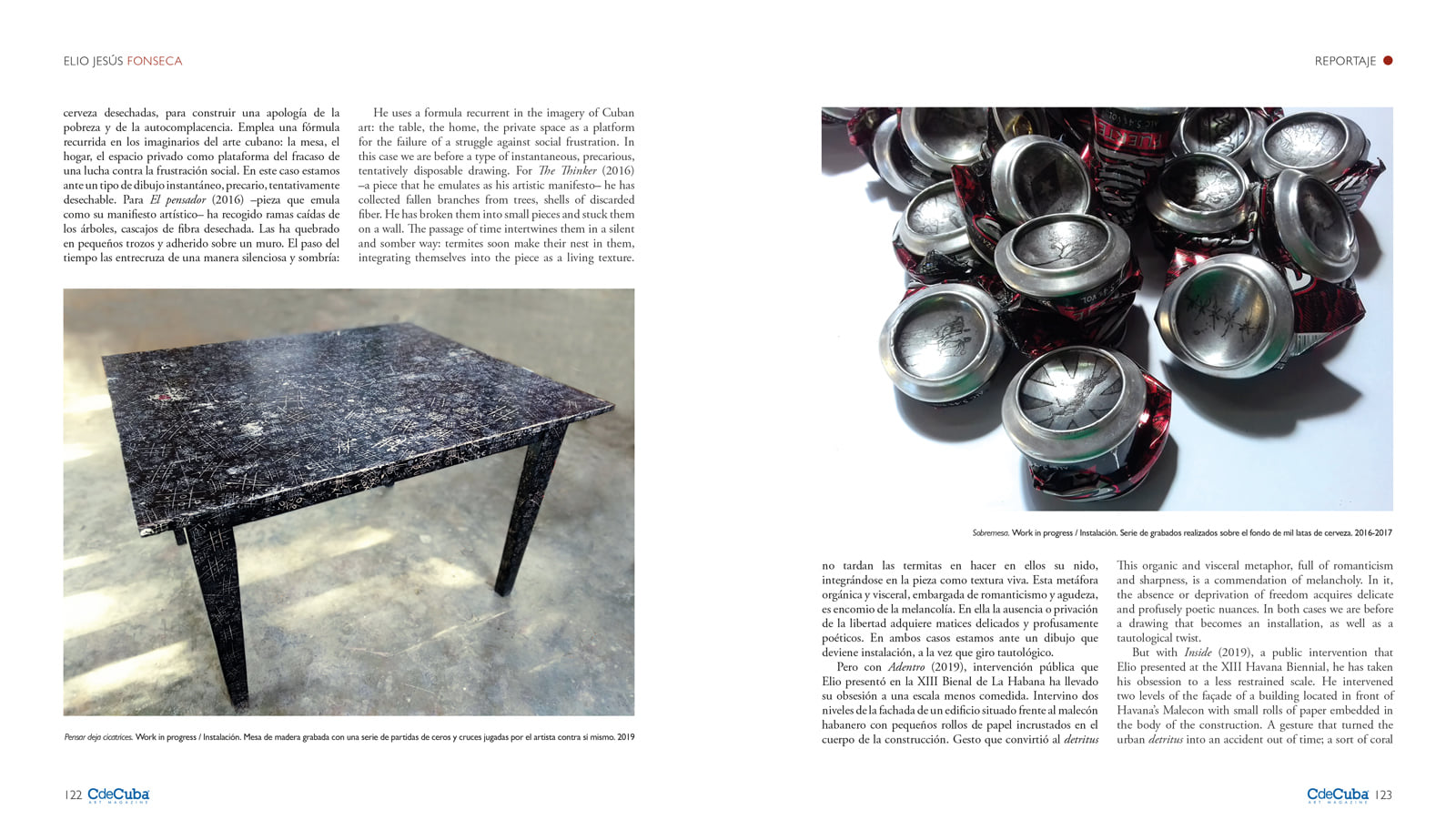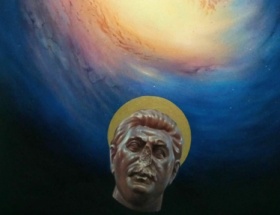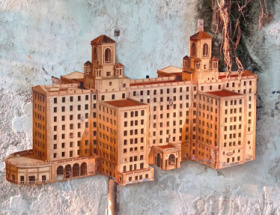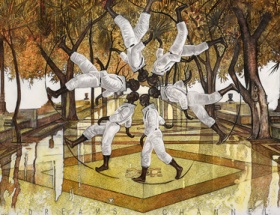The Drawing Instead of the Verb
By Luis Enrique Padrón
Elio Jesús Fonseca’s work has a marked existentialist background. By the choice of materials, the viscerality of his scenes and the somewhat pathetic, somewhat grandiloquent, somewhat self-satisfied effect that he gives it, it could be said that he is satisfied with recycling the anthropological spirit of Cuban art of the eighties. The sensibility of his work also shows a certain imprint of Italian Arte Povera, with regard to the constant conjuring of the organic in his visions and the metaphysical air they possess. His flirtation with these references, in addition to being a critical gesture regarding the frivolity of contemporary culture and aesthetics, is a tempered reflection on the human drama and its daily manifestation. However, his interest in drawing as a language is also notable, a concept to which he resorts through media such as installation or photography.
Especially outstanding are those made in the last year. Illustrations in which the artist idealizes elemental conflicts of human existence under an air of fable. They are small works, with a sober coloring and a remarkable virtuosity. There is no defined narrative line in them other than the stroke and their great evocative capacity. His reference for this series has been animation, graphic design, illustration and the image built with digital methods. Aesthetics appropriated to deploy a handmade iconography with traditional means such as drypoint or nib. The result is retinal for excellence: a corporeal arabesque where masses and textures are strongly intertwined in palimpsest. It is a figuration based on chaos, pain and the resilience of human life. Miniatures of a morphology between humanoid and animalistic, charged with a slightly melancholic epic air that evade the tragic and the monumental at all times.
These works are connected to a group of objects that, with the intention of rethinking the concept of object trouvé, he produced in previous years. Thinking Leaves Scars (2019) is an old wooden table whose surface has been engraved with a game of Three In Line played by the artist against himself ad infinitum. In this one the drawing is incorporated as a symptom of an unhealthy obsession, also a reflection of the wear and tear of vital time. Remembering Is Not Returning (2017), a sympathetic situation in which the protagonist is a CD case meticulously engraved by hand, shows us a haggard stroke that has been assigned the noble function of warning of abandonment and lack, emptiness and decadence. In both cases, more than a support or a technique, the drawing is a place of knowledge, a process, a symbol.
Two pieces are representative in this regard. Tabletop (2017) is the result of a work in progress in which Elio intervenes with subtle vignettes hundreds of discarded beer cans, to build an apology of poverty and complacency. He uses a formula recurrent in the imagery of Cuban art: the table, the home, the private space as a platform for the failure of a struggle against social frustration. In this case we are before a type of instantaneous, precarious, tentatively disposable drawing. For The Thinker (2016) –a piece that he emulates as his artistic manifesto– he has collected fallen branches from trees, shells of discarded fiber. He has broken them into small pieces and stuck them on a wall. The passage of time intertwines them in a silent and somber way: termites soon make their nest in them, integrating themselves into the piece as a living texture. This organic and visceral metaphor, full of romanticism and sharpness, is a commendation of melancholy. In it, the absence or deprivation of freedom acquires delicate and profusely poetic nuances. In both cases we are before a drawing that becomes an installation, as well as a tautological twist.
But with Inside (2019), a public intervention that Elio presented at the XIII Havana Biennial, he has taken his obsession to a less restrained scale. He intervened two levels of the façade of a building located in front of Havana’s Malecon with small rolls of paper embedded in the body of the construction. A gesture that turned the urban detritus into an accident out of time; a sort of coral reef in the middle of the city. His original intention was to seal the wounds of the building, thus preventing it from losing the essence that its body dissipates and represents. But the final result was the staging of the solemnity of an archaeological object, a finding, a trace of our existence beyond time. With a temperament that reminds us of the work of the Bulgarian artist Christo and the young Cuban Duvier del Dago, Elio projects a sort of suite, a doodle, a whimsical architectural redefinition, a commentary on the back of reality.
As we can see, it is an assimilation of drawing as an integrated field of variable scale. This reveals a vision beyond the aesthetics of the sketch or the study –so fertile in contemporary times. They are desperate sketches, clear signs of a nonconformity impossible to verbalize.
